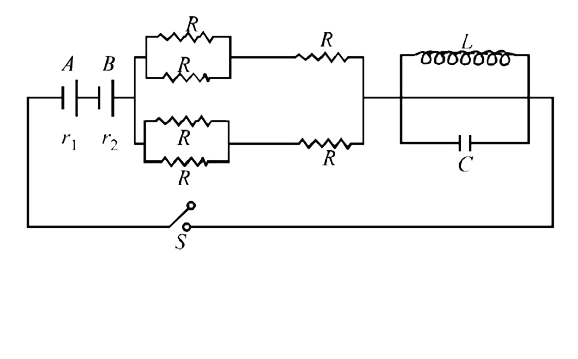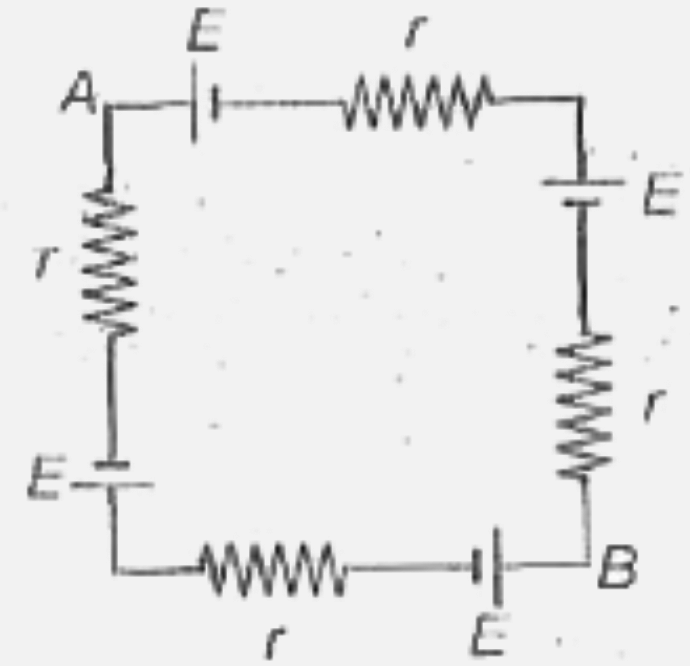Can the potential difference across a battery be greater than its emf?
To determine whether the potential difference across a battery can be greater than its electromotive force (emf), we can analyze the relationship between the potential difference (V), emf (E), current (I), and internal resistance (R) of the battery. Here’s the step-by-step solution:
Step 1: Understand the Definitions
- Electromotive Force (emf, E): This is the maximum potential difference that a battery can provide when no current is flowing.
- Potential Difference (V): This is the voltage across the terminals of the battery when it is connected in a circuit and current is flowing.
Step 2: Use the Formula
The relationship between the potential difference (V), emf (E), current (I), and internal resistance (R) of the battery is given by the formula:
V=E−I⋅R
Step 3: Analyze the Formula
From the formula:
- When there is no current flowing (I = 0), the potential difference (V) equals the emf (E).
- When current flows (I > 0), the term I⋅R (which represents the voltage drop due to internal resistance) is subtracted from the emf.
Step 4: Conclusion
Since I⋅R is always a positive value when current is flowing, it follows that:
V=E−I⋅R<E
This means that the potential difference (V) across the battery cannot exceed the emf (E) when current is flowing.
Final Answer
Thus, the potential difference across a battery cannot be greater than its emf. The answer to the question is No.
---
- Electromotive Force (emf, E): This is the maximum potential difference that a battery can provide when no current is flowing.
- Potential Difference (V): This is the voltage across the terminals of the battery when it is connected in a circuit and current is flowing.
The relationship between the potential difference (V), emf (E), current (I), and internal resistance (R) of the battery is given by the formula:
V=E−I⋅R
From the formula:
- When there is no current flowing (I = 0), the potential difference (V) equals the emf (E).
- When current flows (I > 0), the term I⋅R (which represents the voltage drop due to internal resistance) is subtracted from the emf.
Since I⋅R is always a positive value when current is flowing, it follows that:
V=E−I⋅R<E
This means that the potential difference (V) across the battery cannot exceed the emf (E) when current is flowing.
Thus, the potential difference across a battery cannot be greater than its emf. The answer to the question is No.
Topper's Solved these Questions
- BOOK - HC VERMA ENGLISHCHAPTER - ELECTRIC CURRENT IN CONDUCTORSEXERCISE - Exercises84videos
ELECTRIC CURRENT IN CONDUCTORS
- BOOK - HC VERMA ENGLISHCHAPTER - DISPERSION AND SPECTRAEXERCISE - Question for short Answer6videos
DISPERSION AND SPECTRA
- BOOK - HC VERMA ENGLISHCHAPTER - ELECTRIC CURRENT THROUGH GASESEXERCISE - Short answer6videos
ELECTRIC CURRENT THROUGH GASES
Similar Questions
Knowledge Check
- Question 1 - Select One
A voltmeter having a resistance of 1800Ω employed to measure the potential difference across a 200Ω resistor which is connected to the terminals of a dc power supply having an emf of 50 V and an internal resistance of 20Ω. What is the percentage decrease in the potential difference across the 200Ω resistor as a result of connecting the voltmeter across it?
A1%B5%C10%D25%
A high resistance voltmeter measures the potential difference across a battery to be 9-0 V. On connecting a 24 2 resistor across the terminals of the battery, the voltmeter reads 7.2 V. Calculate the internal resistance of the battery.
View SolutionWhat is terminal potential differnce of a cell? Can its value be greater than the emf of a cell? Explian.
View SolutionAn inductor of inducance 5.0 H, having a negligible resistance, is connected in series with a 100Ω resistor and a battery of emf 2.0 V. Find the potential difference across the resistor 20 ms after the circuit is switched on.
View SolutionA voltmeter of resistance 994Ω is connected across a cell of emf 1 V and internal resistance 6Ω. Find the potential difference across the voltmeter, that across the terminals of the cell and percantage error in the reading of the voltmeter.
View SolutionIn the figure both cells A and B are of equal emf. Find R for which potential difference across battery A will be zero, long time after the switch is closed. Internal resistance of batteries A and B (r1)and(r2) respectively(r1>r2).
 View Solution
View SolutionPotential difference across AB in the network shown is
 View Solution
View SolutionPotential difference across AB in the network shown is
 View Solution
View Solution


